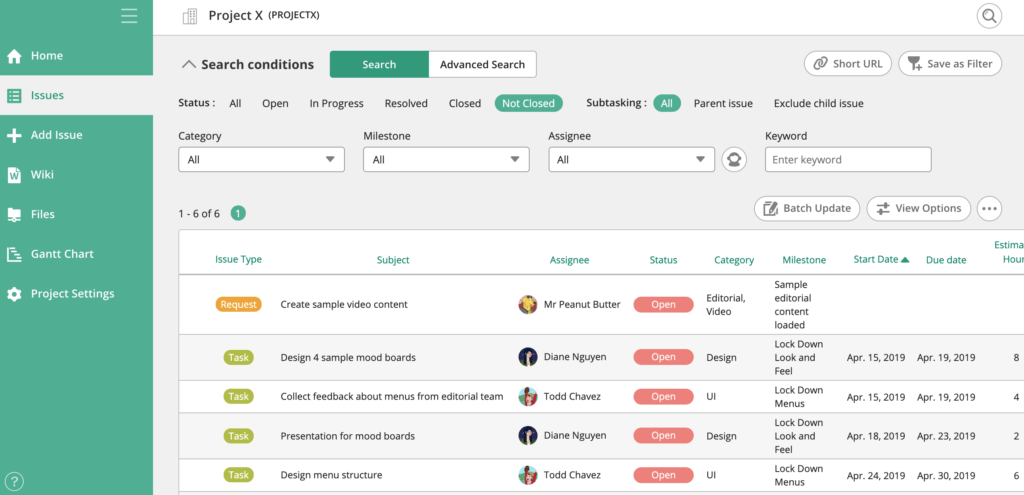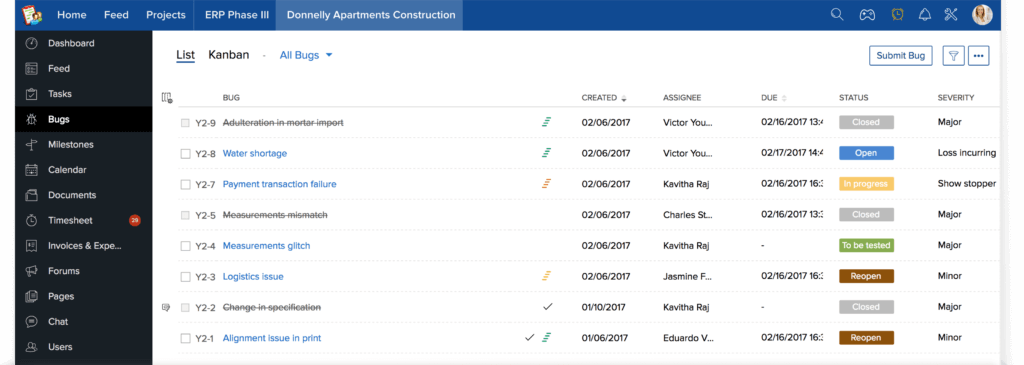Best Free Bug Tracking Tools
The best programmers, back-end developers, and content managers still come across bugs that need to be recorded. No matter the reason for the bug, accurate bug tracking software allows for better visibility and a better experience for customers and staff. The various types of free bug trafficking software have different levels of complexity and integration with other tools. Understanding the options available will help you make the best choice in free bug tracking software for you.
| User Limit | Storage Limit | Visualization | Open-Source | |
| Zoho BugTracker | 3 | Files up to 10MB | Kanban | No |
| BugZilla | Unlimited | Local | Limited | Yes |
| Backlog | 10 | 100 MB | Kanban | Yes |
| OpenProject | Unlimited | Files up to 256 MB | Gantt, Kanban (By Extension) | Yes |
| Jira | 10 | 2GB | Gantt, Kanban | No |
Purely Bug Tracking Software
Many software that includes a bug tracker have other features included in their base versions. The most common software to include this is project management software. First, we will go over the software that is just for bug tracking and little else.
Zoho Bugtracker – Best for Zoho Users
Regulars to the TrustRadius buyer blog will not be surprised to find a Zoho product included in a free software recommendation. A vendor with seemingly endless scope, Zoho offers its version of a pure bug tracking software, Zoho Bugtracker.
Zoho Bugtracker is relatively barebones, but a fantastic option for those who use Zoho software. For up to 3 users, the free version allows for up to 2 projects. Attachments are limited to 10MB. The bug reports are more basic versions of what the software is capable of. Advanced bug reporting is available through the paid tiers.
With this, you will get access to the intuitive bug tracking feature. This allows for a calendar view and document management system. Bugs can be imported from CSV and Jira. Project feeds allow for great user access in a visual, easy-to-use system.
Unusually for Zoho products, the free version does not directly integrate with some of the most common Zoho tools. Zoho Desk, Analytics, Zoho projects, and Books/Invoice do not directly integrate with the fee version. Despite this, those familiar with the vendor will still find comfort with the familiar UI. Zoho products also tend to be well made and bug-free.
Zoho Bugtracker does include Zapier integration which will allow you to process automation and integration with other software. This will depend on your Zapier experience and pricing.
In summary, Zoho Bugtracker is great for small teams with one or two projects, who need a simple bug tracking tool. Those with limited experience will find the vendor-supported software more comfortable than an open-source tool. Additionally, this is a newer software, so does not have the dated look of some on this list.
BugZilla – Old-Fashioned, Powerful Bug Tracking
When talking about bug tracking software, BugZilla is the old man on the block. Initially released in 1998 (!), this tool offers reliable, tested bug tracking, albeit in a more dated format.
There are more powerful features than some of the more polished software on this list. This is great for those who can get past the dated UI. Advanced organizational features like custom search parameters and scheduled reporting allow for a more tailored experience. Users can also take advantage of the time-tracking features, should they need it.
Bugzilla has a useful feature for developers where it can look for similar issues once one has been detected. Users type a description of the issue, and the system will automatically search for bugs that may be the same. Users can then deal with these at once.
This software has no real limits on the users, because of the license it operates on. The process for adding users is a little more complicated than some other software. Once done, administrators have extensive control over user access and security. Admins can even use the “watch” feature. This will inform them of whenever a user gets an email, and send it to them as well. This can allow for better vacation scheduling and two-level workflows.

The requesting system allows users to directly ask for a specific action to be taken on a project. This is great for collaboration. You could use this in tandem with time-tracking, figure something will take 4 hours, then assign it to the user.
Extensions are widely supported, but community-made. These are written in many different languages, and inserted directly into the program. These range from data harvesting to agile tools.
In summary, BugZilla is a very powerful bug tracking tool that will be as useful as your skill level allows it to be. It is not the most user-friendly software. It will take time and tech background to make the most of. For programming teams and software development, this is a strong way of organizing and assigning bugs to be fixed. Ensure each member of the team that will be using this has the ability to learn to do so.
Bug Tracking in Project Management Software
These software contain bug tracking as part of a larger platform. These enable bug fixes to be a part of your larger workflow. Software development projects that use project management value custom workflows, milestones, and file attachments. These make software bugs easy to track and manage through the editing process. All of these software are part of a free plan or are open source.
Backlog – Bug Tracking for Small Teams
Backlog is the first project management software on this list, but has a strong bug tracking focus. This software is lightweight, easy to use, and is less extensive than others.
Backlog allows for 1 project between up to 10 users. There is a storage cap of 100MB. For this, users get strong issue management functionality. These features allow a team to set tasks and assign due dates. Tasks can be updated and easily moved around to stay on schedule.
Programmers can make use of the review and collaboration features in this free software. Git, Subversion, and Wiki are all supported in every version of this tool, including the free one. You can see who is working on what, track versions, and review changes.

One of the big benefits of Backlog is the board view. This allows for a much more visual way to see what needs to be done than some of the lighter tools mentioned above. This is much more friendly if there are members of your staff with less of a tech background.
For added security measures, Backlog supports two-factor authentication and hosting on their website.
In summary, this is a fantastic way for teams to collaborate and organize while tracking their bugs. The interface is easy to use, and the board view is intuitive and great for organization. A small team collaborating on any type of smaller project would benefit from this software. Larger teams would need to pay to upgrade. The same is true for those with multiple projects or larger file sizes.
OpenProject – Open-source Bug Tracking and Project Management
OpenProject Community is a free, open-source project management tool that can serve as a fantastic bug tracking software for your organization. Best of all, it offers unlimited users and unlimited projects.
Like Bugzilla it offers issue tracking and task management features to help programmers keep track of crucial bugs. These can be viewed in a Gantt chart view for better visualization. Time visualization can be color-coded and given different statues. Managers can see what is on time and what is in the correct development stage. They can also easily see what is coming up, allowing for better project planning.
Time-tracking features are also available, like in Bugzilla. In combination with the Gantt charts, this becomes more useful. Users and managers can allocate time more accurately. This prevents bottlenecks and improves efficiency in project development.

Cost tracking and product roadmaps allow developers to better manage both their time and money. This will allow them to more effectively keep track of many projects at once. Those using freelancer developers and consultants will appreciate this feature.
The user interface is far more friendly than an older tool like Bugzilla, though not as polished as a SaaS product from a vendor like Zoho. In summary, this software offers a strong host of project management and bug tracking features. OpenProject uses the benefits of open-source software to its advantage while staying accessible to more inexperienced users.
Jira – Reliable Bug Management From a PMS
Jira is definitely not a dedicated bug-tracking software but does the job well enough to earn a spot on this list. This software is for those with less tech experience, who want a trusted, easy-to-use system for a small team.
This software will offer a level of professional polish and user-friendliness to your bug tracking. The Jira engine offers a powerful way to organize the bug tracking and repair process. This is done through its issue creation system. Users fill out a ticket, with a description, severity level, images, and other important information.
Once created, these can be assigned to various team members based on urgency and user skill sets. Where Jira really shines is in the organization of this process. Both Kanban and Gantt chart views are available in the free version. There is a user cap of 10 users, and a file storage limitation of 2GB.
Jira also offers strong security and compliance features. SSO and active directory sync are included in the free version. Mobile device management works with dedicated app support for both iOS and Android devices. Management can require verification after a certain session time, further maximizing security.
Overall, Jira will probably offer a more organized project management experience, with the bug-tracking feature enabled, than many software on this list. It is less suited to real-time software collaboration. This is software if your bug-tracking is more of an organizational issue than a collaborative and programing one.
More Information on Bug Tracking Options.
For those who find that bug-tracking is an organizational issue, consider project management software. This type of tool often includes issue tracking and development visualization to help with these logistical issues.
If you are working on a programming project that you need bug tracking for, consider watching the video below. This will give you advice on planning and building coding projects more effectively.
Was this helpful?


